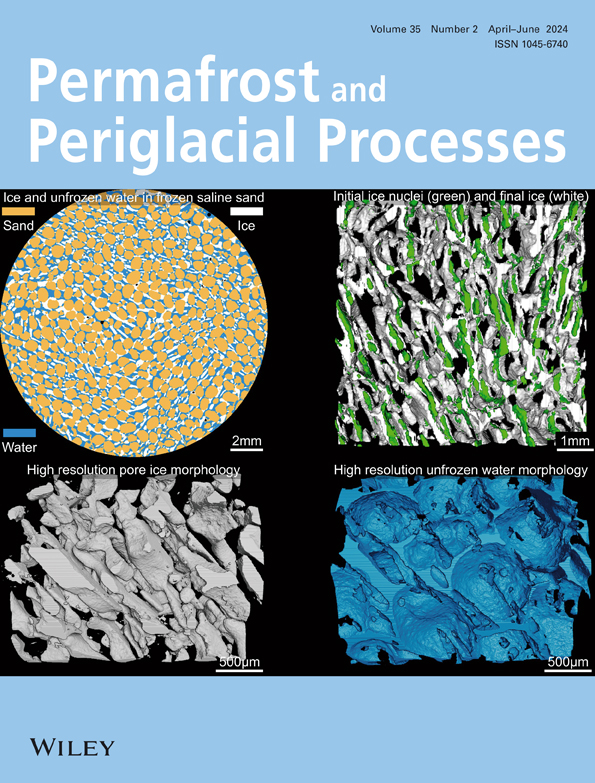The soil–cryogenic complex: Evidence of late Pleistocene–Holocene coevolution of permafrost and cryosols at the Kolyma Lowland
IF 3.3
3区 地球科学
Q2 GEOGRAPHY, PHYSICAL
引用次数: 0
Abstract
One of the most important problems of cryopedology is the interaction of pedogenic processes with the processes that form the structure of the uppermost layers of the near‐surface permafrost. The thickness, structure, spatial variability, and other features are responsible for the reaction of the soil‐permafrost system to the bioclimatic fluctuations as well as the contemporary anthropogenic pressure. Together the soil profile and the upper layers of permafrost form the natural body of the “soil–cryogenic complex,” which is the result of simultaneous late Pleistocene–Holocene soil and permafrost coevolution. Pedogenic and cryogenic processes together form organic‐accumulative horizons above the permafrost table that have often been described in the profiles of Cryosols in different regions of Arctic. The multiannual dynamics of summer thawing depth determine the involvement of the material of these shielding horizons into the zone of active modern pedogenesis or its exclusion from it in case of their frozen state. Soil surface microrelief, complexity of the vegetation, and spatial differences of thermal properties of the suprapermafrost soil horizons and the transient layer of permafrost are responsible for the complicated pattern of permafrost table microrelief. Thus, the long‐term study of cryogenic soils that are developed on the close underlying permafrost provides improved understanding of the natural‐historical body—soil‐cryogenic complex.土壤-低温复合体:柯瑞玛低地晚更新世-全新世冻土与冻土共同演化的证据
低温学最重要的问题之一是成土过程与形成近地表永久冻土层最上层结构的过程之间的相互作用。土壤—永久冻土系统的厚度、结构、空间变异性等特征决定了其对生物气候波动和当代人为压力的反应。土壤剖面和上层永久冻土层共同构成了“土壤-低温复合体”的自然主体,这是晚更新世-全新世土壤和永久冻土层同时共同进化的结果。成土过程和低温过程共同形成了永久冻土层之上的有机累积层,这在北极不同地区的冻土剖面中经常被描述。夏季融化深度的多年动态决定了这些屏蔽层的物质是参与到活跃的现代成土作用区,还是在冻结状态下将其排除在活跃的现代成土作用区之外。土壤表层微起伏、植被的复杂性、冻土上土层和永久冻土瞬变层热性质的空间差异是冻土表层微起伏复杂格局的主要原因。因此,对在近下伏的多年冻土上发育的低温土壤进行长期研究,有助于更好地理解自然-历史的体-土-低温复合体。
本文章由计算机程序翻译,如有差异,请以英文原文为准。
求助全文
约1分钟内获得全文
求助全文
来源期刊
CiteScore
9.70
自引率
8.00%
发文量
43
审稿时长
>12 weeks
期刊介绍:
Permafrost and Periglacial Processes is an international journal dedicated to the rapid publication of scientific and technical papers concerned with earth surface cryogenic processes, landforms and sediments present in a variety of (Sub) Arctic, Antarctic and High Mountain environments. It provides an efficient vehicle of communication amongst those with an interest in the cold, non-glacial geosciences. The focus is on (1) original research based on geomorphological, hydrological, sedimentological, geotechnical and engineering aspects of these areas and (2) original research carried out upon relict features where the objective has been to reconstruct the nature of the processes and/or palaeoenvironments which gave rise to these features, as opposed to purely stratigraphical considerations. The journal also publishes short communications, reviews, discussions and book reviews. The high scientific standard, interdisciplinary character and worldwide representation of PPP are maintained by regional editorial support and a rigorous refereeing system.

 求助内容:
求助内容: 应助结果提醒方式:
应助结果提醒方式:


